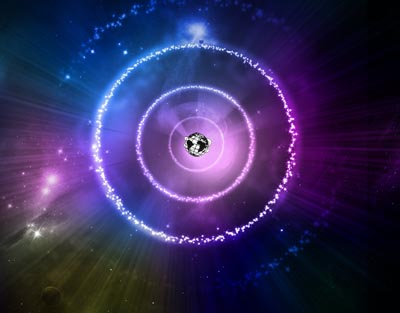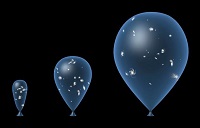New discoveries about the organization of the galaxies in space are challenging what big bang theorists have always believed about the the structure of the universe. The new evidence challenges the tenets of the popular but disputed big bang theory down to its core. Even though the big bang was first proposed by a belgian priest named Georges Lemaitre, it is essentially a secular theory stating only naturalistic causes are responsible for the creation of the universe. That being the case there are two essential assumptions key to the theory which are required to maintain the appearance of the creation of the universe being an entirely natural event.
Those two key assumptions are that the universe is both homogenous and isotropic. "Homogenous" refers to the supposition that the matter in the universe is evenly distributed. "Isotropic" assumes that where ever you look and from whatever vantage point you look, the universe would look the same. Or as NASA puts it:
" ...if you viewed the contents of the universe with sufficiently poor vision, it would appear roughly the same everywhere and in every direction. That is, the matter in the universe is homogeneous and isotropic when averaged over very large scales. This is called the Cosmological Principle."1
These two principles are necessary to prevent the conclusion of special creation particularly in light of Hubble's discovery in 1929 that resulted in the law that bears his name. That discovery - based on observing the red shift of galaxies2 - is that all galaxies are moving away from us. And the further away the galaxy is, the faster it's moving. This is true in whatever direction you look - everything is moving away from us, and the most distant ones are moving fastest. It doesn't take a genius to figure that fact appears to put us at the center of the universe. Hubble, an atheist, abhorred that thought. Putting our planet at the center of the universe is not the expected outcome of a lifeless, careless explosion. That is more like something a loving God who wanted us to have a good vantage point would do. How to over come that and keep the appearance of a naturalistic process?
Thus the big bang requires that the universe is both homogenous and isotropic.3
But the latest discovery by scientists indicates that the universe is neither homogenous nor isotropic. Instead of being the equivalent of an amorphous blob, scientists are discovering there is a distinct structure to the universe, and the earth appears to be in the center of it.
Regarding the structure of space, space.com reports:
"...researchers have announced the discovery of a truly monstrous structure consisting of a ring of galaxies around 5 billion light-years across.
The galactic ring, which was revealed by 9 gamma-ray bursts (GRBs), is located 7 billion light-years away and spans an area of the sky more than 70 times the diameter of a full moon.
...
'If we are right, this structure contradicts the current models of the universe. It was a huge surprise to find something this big — and we still don't quite understand how it came to exist at all,' added Balazs."4
The above structure should not exist. But it gets better - (meaning worse for big bang supporters). Regarding the earth being at the center of the universe, as I noted in my previous article (on the Kepler 452b exoplanet dubbed Earth 2.0), based on evidence from the Two-degree-field Galaxy Red Shift Survey (2dFGRS) and the Sloan Digital Sky Survey (SDDS), physicist and cosmologist Dr. John Hartnett is investigating evidence of one of the largest super structures every observed in space: galaxies arranged in concentric circles and part of a super structure of 4 billion light years across. And to top it off: our humble galaxy appears to be at or near the center of this super structure.5
Further research is continuing on these fronts, but the initial evidence appears clear: space is arranged in a super structure of galaxies arranged in concentric circles, and our galaxy, the milky way is at or near the center of it. If this is true it totally blows the big bang and its complete reliance on natural processes out of the water, because that is clearly a designed structure. Natural explosions don't create concentric rings of matter and put an observation platform conveniently in the middle. That is the work of a designer. And as even atheist scientists will admit, a designed structure requires a designer.
I had originally intended to title this article "The Late Great Big Bang Theory", because with this latest evidence the big bang has the final nails hammered into its coffin as the evidence for design is inescapable. But as I have written about previously, like evolution, the big bang, is not science; it is religion. And believers in this religion will not let it go easily. They will attempt to rise to this clear challenge. How have they risen to past challenges? I have documented previously the typical response: fairytales.6 When challenged with the impossibly even temperature of the cosmic microwave background radiation (CMB) of the universe and the horizon problem, a big bang scientist came up with an impossible solution - the idea of "cosmic inflation." The rest of the big bang gang, - having no other solution - jumped on the band wagon.
When faced with the problem of the extreme fine tuning of the universe (another impossibility for a randomly created universe), what did scientists come up with? The fairy tale of the multiverse - the theory there are an infinite number of universes, all with different values for laws of nature such as the gravitational constant and the electromagnetic force constant7 - and we just happened to wind up in a universe where they are all precisely set for life. When challenged with distant galaxies moving much faster than they should, and the universe expanding much faster than expected, what did they come up with? The hypothetical concepts of "dark matter" and "dark energy" respectively. In theory 96% of everything that exists in the universe is made out of dark matter, yet scientists can find no evidence of it.8 (The remaining 4% is regular matter - the stuff we're made of and can see.) Nor do they have any evidence of dark energy.
Given their history and propensity to make up stories to save their deeply ensconced theory, it is clear even this clear evidence will not be sufficient for them to admit the theory is simply wrong. If they can say with a straight face, and actually believe that the universe and everything in it exploded into existence out of nothing and formed itself, then this simple evidence of a clearly designed structure will not persuade them.
So instead, let me make a prediction: Be
prepared for another outrageous story to explain away the super
structure of the universe that evidence is making increasingly clear. I
don't know what this new theory will be - whether "dark
cosmic collisions of branes (cosmic membranes separated by a fourth
dimension) that result in rings of matter
like dropping pebbles in a pond" or
perhaps "a dark mystery field that gives the missing anti-matter9
a property that forms them into a torus or halo which them pulls matter
around them into a naturally formed super structure." Scientists
have plenty of imagination - they'll come up with something. I
don't know what it will be, but they'll come up with something. They
have to - they'll need it to prop up the
failed theory in the light of new conclusive evidence against it.
To close, let me borrow from the former president of the men's
warehouse:
Another big bang fairy tale is coming. I guarantee it.
And when it comes, I'll update this article with the story they
come up with.
Duane Caldwell | posted 8/31 /2015
Follow @rationalupdates
Update 3/4/2017
As guaranteed, cosmologists have a new fairy tale: invisible dark matter
aliens.
Read about it in
The Expanding Big Bang Fairy Tale
However there's still one yet to come - about the location of the earth
in universe as detailed above.
- DC
Update 3/8/2019
The next item updates problems highlighted in this article:
The Coming Big Bang Fairytale ... has arrived
Notes
1
WMAP Big Bang Theory, NASA, updated 3/1/2012,
http://map.gsfc.nasa.gov/universe/bb_theory.html
back
2 The assumptions of being homogeneous and isotropic
are also required for the equations used to quantify aspects of the big
bang such as the age of the universe. If those assumptions are not made,
the equations are invalid.
back
3 Like an approaching siren sounds higher pitched
and louder, and a receding one sounds lower pitched and softer,
approaching galaxies have their light waves compressed together
resulting in shorter wave lengths that we see as bluer or blue shifted,
while receding galaxies have their wavelengths stretched out resulting
in longer wavelengths that we see as redder - or red shifted.
back
4 Ian O'Neill, Giant Mystery Ring of Galaxies Should
Not Exist, Discovery News, 8/7/2015
http://www.space.com/30166-giant-galaxy-ring-should-not-exist.html
back
5
John Hartnett, In the Middle of the Action, CMI DVD, 2009
back
6.
Duane Caldwell,
The multiverse and other fairy tales, 8/10/2015
http://rationalfaith.com/2015/08/the-multiverse-and-other-fairytales/
back
7.
For a partial listing of fine tuning evident in the physical laws of the
universe, see
Hugh Ross, Fine-Tuning For Life In The Universe, 2/13/2009
http://www.reasons.org/articles/fine-tuning-for-life-in-the-universe
back
8 Physicist John Hartnett notes that dark matter has
not been found after 40 years of searching for it in laboratory
experiments. See:
John G. Hartnett Stars just don’t form naturally—‘dark matter’ the
‘god of the gaps’ is needed,
9/1/2015
http://creation.com/stars-dont-form-naturally
back
9 The big bang theory posits that all
matter was created in the big bang event. If that were true, equal
amounts of matter and anti-matter would have been created. Fortunately
for us, that is not the case, since matter and anti-matter annihilate
each other on contact. But the fact that the universe is composed of
almost exclusively matter, and anti-matter is extremely rare, poses a
big problem for the big bang. For more see:
Michael J. Oard Missing Antimatter Challenges the
’Big Bang’ Theory 12/1/1998
https://answersingenesis.org/big-bang/missing-antimatter-challenges-the-big-bang-theory/
back

